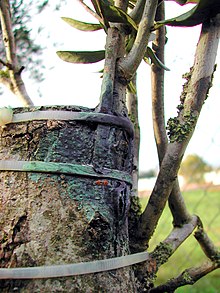Plates

Plates or stems are a technical term used in horticulture and denote a type of plant refinement . This technique is used when the diameter of the finishing underlay is not the same as that of the noble rice . It is done in spring and summer. Plating is a variant of grafting , characterized by an independent process in the implementation of the cutting technique and the time of finishing.
When processing in spring, make sure that the noble rice is in hibernation. It should be cut in January in open weather, and stored in a cool, but frost-free place until the time of grafting, so that it is not yet driven. Conifers , currants and gooseberries are refined using this method. This process is also used for citrus plants.
In this case, a 3 to 4 cm long tongue is cut a few millimeters deep on the base, which is not thrown off (cut off) in contrast to the goat's foot refinement or the otherwise usual plug. A horizontal cut is then made at the bottom with the back of the knife pointing upwards at an angle so that the tongue falls out and can be thrown away.
An oval copulation cut the length of the previously cut out tongue of the pad is made on the noble rice with about 3 to 4 eyes . Then cut horizontally at the bottom of the back of the oval copulation cut of the noble rice, so that the noble rice fits exactly into the tongue section of the base. Afterwards you insert the noble rice into the cutout of the base , whereby the cambium surfaces should overlap, if that doesn't work completely, you have to make sure that they overlap at least on one side. Then the finishing area is wrapped with raffia or a rubber band and tied, and all interfaces are carefully covered with tree wax. This is not necessary with conifers .
In the following winter, during summer processing (currants and gooseberry trees), the remaining crown is thrown off (cut off) about 10 cm above the base, and the rest is removed completely in spring, whereby the cut surface must be spread with tree wax. The paving can be done outdoors, but also with container plants.
With conifers, half of the wildling is cut off after 3 weeks. After 3 more weeks you can remove the whole wildling.
Lateral flattening
This technique is mainly used in deciduous trees, but it can also be useful for raising standard gooseberries . A tongue of bark pointing upwards is peeled off the side of the base, the noble rice is cut oval on the front and back and inserted into the gap between the base wood and the bark. Proceed as described above.